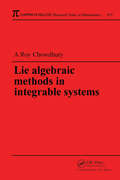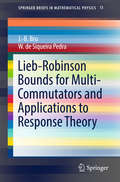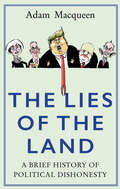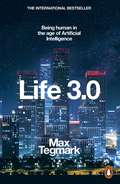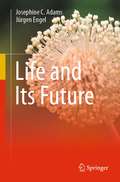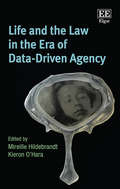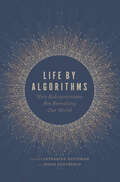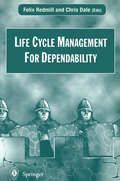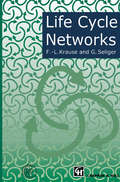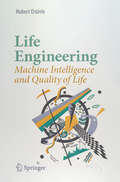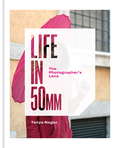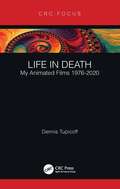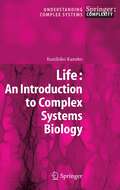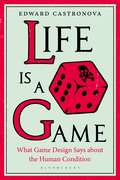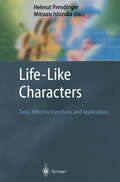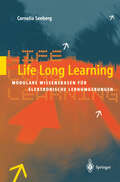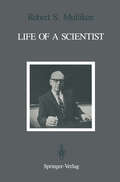- Table View
- List View
Lie Algebraic Methods in Integrable Systems
by Amit K. Roy-ChowdhuryOver the last thirty years, the subject of nonlinear integrable systems has grown into a full-fledged research topic. In the last decade, Lie algebraic methods have grown in importance to various fields of theoretical research and worked to establish close relations between apparently unrelated systems. The various ideas associated with Lie algebra and Lie groups can be used to form a particularly elegant approach to the properties of nonlinear systems. In this volume, the author exposes the basic techniques of using Lie algebraic concepts to explore the domain of nonlinear integrable systems. His emphasis is not on developing a rigorous mathematical basis, but on using Lie algebraic methods as an effective tool.The book begins by establishing a practical basis in Lie algebra, including discussions of structure Lie, loop, and Virasor groups, quantum tori and Kac-Moody algebras, and gradation. It then offers a detailed discussion of prolongation structure and its representation theory, the orbit approach-for both finite and infinite dimension Lie algebra. The author also presents the modern approach to symmetries of integrable systems, including important new ideas in symmetry analysis, such as gauge transformations, and the "soldering" approach. He then moves to Hamiltonian structure, where he presents the Drinfeld-Sokolov approach, the Lie algebraic approach, Kupershmidt's approach, Hamiltonian reductions and the Gelfand Dikii formula. He concludes his treatment of Lie algebraic methods with a discussion of the classical r-matrix, its use, and its relations to double Lie algebra and the KP equation.
Lie Algebraic Methods in Integrable Systems
by Amit K. Roy-ChowdhuryOver the last thirty years, the subject of nonlinear integrable systems has grown into a full-fledged research topic. In the last decade, Lie algebraic methods have grown in importance to various fields of theoretical research and worked to establish close relations between apparently unrelated systems. The various ideas associated with Lie algebra and Lie groups can be used to form a particularly elegant approach to the properties of nonlinear systems. In this volume, the author exposes the basic techniques of using Lie algebraic concepts to explore the domain of nonlinear integrable systems. His emphasis is not on developing a rigorous mathematical basis, but on using Lie algebraic methods as an effective tool.The book begins by establishing a practical basis in Lie algebra, including discussions of structure Lie, loop, and Virasor groups, quantum tori and Kac-Moody algebras, and gradation. It then offers a detailed discussion of prolongation structure and its representation theory, the orbit approach-for both finite and infinite dimension Lie algebra. The author also presents the modern approach to symmetries of integrable systems, including important new ideas in symmetry analysis, such as gauge transformations, and the "soldering" approach. He then moves to Hamiltonian structure, where he presents the Drinfeld-Sokolov approach, the Lie algebraic approach, Kupershmidt's approach, Hamiltonian reductions and the Gelfand Dikii formula. He concludes his treatment of Lie algebraic methods with a discussion of the classical r-matrix, its use, and its relations to double Lie algebra and the KP equation.
Lieb-Robinson Bounds for Multi-Commutators and Applications to Response Theory (SpringerBriefs in Mathematical Physics #13)
by J. B. Bru W. de Siqueira PedraLieb-Robinson bounds for multi-commutators are effective mathematical tools to handle analytic aspects of infinite volume dynamics of non-relativistic quantum particles with short-range, possibly time-dependent interactions.In particular, the existence of fundamental solutions is shown for those (non-autonomous) C*-dynamical systems for which the usual conditions found in standard theories of (parabolic or hyperbolic) non-autonomous evolution equations are not given. In mathematical physics, bounds on multi-commutators of an order higher than two can be used to study linear and non-linear responses of interacting particles to external perturbations. These bounds are derived for lattice fermions, in view of applications to microscopic quantum theory of electrical conduction discussed in this book. All results also apply to quantum spin systems, with obvious modifications. In order to make the results accessible to a wide audience, in particular to students in mathematics with little Physics background, basics of Quantum Mechanics are presented, keeping in mind its algebraic formulation. The C*-algebraic setting for lattice fermions, as well as the celebrated Lieb-Robinson bounds for commutators, are explained in detail, for completeness.
The Lies of the Land: An Honest History of Political Deceit
by Adam MacqueenTrust in our politicians is at an all-time low. We're in a "post-truth" era, where feelings trump facts, and where brazen rhetoric beats honesty. But do politicians lie more than they used to? And do we even want them to tell the truth?In a history full of wit and political acumen, Private Eye journalist Adam Macqueen dissects the gripping stories of the biggest political lies of the last half century, from the Profumo affair to Blair's WMDs to Boris Johnson's £350 million for the NHS. Covering lesser known whoppers, infamous lies from foreign shores ("I did not have sexual relations with that woman"), and some of the resolute untruths from Donald Trump's explosive presidential campaign, this is the quintessential guide to dishonesty from our leaders - and the often pernicious relationship between parliament and the media.But this book is also so much more. It explains how in the space of a lifetime we have gone from the implicit assumption that our rulers have our best interests at heart, to assuming the worst even when - in the majority of cases - politicians are actually doing their best.
Life 3.0: Being Human in the Age of Artificial Intelligence
by Max Tegmark'This is the most important conversation of our time, and Tegmark's thought-provoking book will help you join it' Stephen HawkingTHE INTERNATIONAL BESTSELLER. DAILY TELEGRAPH AND THE TIMES BOOKS OF THE YEARAI is the future - but what will that future look like? Will superhuman intelligence be our slave, or become our god?Taking us to the heart of the latest thinking about AI, Max Tegmark, the MIT professor whose work has helped mainstream research on how to keep AI beneficial, separates myths from reality, utopias from dystopias, to explore the next phase of our existence.How can we grow our prosperity through automation, without leaving people lacking income or purpose? How can we ensure that future AI systems do what we want without crashing, malfunctioning or getting hacked? Should we fear an arms race in lethal autonomous weapons? Will AI help life flourish as never before, or will machines eventually outsmart us at all tasks, and even, perhaps, replace us altogether? 'This is a rich and visionary book and everyone should read it' The Times
Life and Its Future
by Josephine C. Adams Jürgen EngelThis book is aimed at those who wish to understand more about the molecular basis of life and how life on earth may change in coming centuries. Readers of this book will gain knowledge of how life began on Earth, the natural processes that have led to the great diversity of biological organisms that exist today, recent research into the possibility of life on other planets, and how the future of life on earth faces unprecedented pressures from human-made activities. Readers will obtain a perspective on the potential risks of chemical or nuclear warfare, and the ever-increasing risks from human activities that are causing pollution and climate change with global heating. Readers will also learn about ongoing research efforts to generate “designer lifeforms” through synthetic biology and applications of artificial intelligence. The book makes an integrated, up-to-date, overview of topics often considered as separate fields. It should be valuable to students, teachers, and people who are concerned about the future of life.
Life and the Law in the Era of Data-Driven Agency
by Kieron O’Hara Mireille HildebrandtThis ground-breaking and timely book explores how big data, artificial intelligence and algorithms are creating new types of agency, and the impact that this is having on our lives and the rule of law. Addressing the issues in a thoughtful, cross-disciplinary manner, the authors examine the ways in which data-driven agency is transforming democratic practices and the meaning of individual choice. Leading scholars in law, philosophy, computer science and politics analyse the latest innovations in data science and machine learning, assessing the actual and potential implications of these technologies. They investigate how this affects our understanding of such concepts as agency, epistemology, justice, transparency and democracy, and advocate a precautionary approach that takes the effects of data-driven agency seriously without taking it for granted. Scholars and students of law, ethics and philosophy, in particular legal, political and democratic theory, will find this book a compelling and invaluable read, as will computer scientists interested in the implications of their own work. It will also prove insightful for academics and activists working on privacy, fairness and anti-discrimination.
Life by Algorithms: How Roboprocesses Are Remaking Our World
by Catherine Besteman Hugh GustersonComputerized processes are everywhere in our society. They are the automated phone messaging systems that businesses use to screen calls; the link between student standardized test scores and public schools’ access to resources; the algorithms that regulate patient diagnoses and reimbursements to doctors. The storage, sorting, and analysis of massive amounts of information have enabled the automation of decision-making at an unprecedented level. Meanwhile, computers have offered a model of cognition that increasingly shapes our approach to the world. The proliferation of “roboprocesses” is the result, as editors Catherine Besteman and Hugh Gusterson observe in this rich and wide-ranging volume, which features contributions from a distinguished cast of scholars in anthropology, communications, international studies, and political science. Although automatic processes are designed to be engines of rational systems, the stories in Life by Algorithms reveal how they can in fact produce absurd, inflexible, or even dangerous outcomes. Joining the call for “algorithmic transparency,” the contributors bring exceptional sensitivity to everyday sociality into their critique to better understand how the perils of modern technology affect finance, medicine, education, housing, the workplace, food production, public space, and emotions—not as separate problems but as linked manifestations of a deeper defect in the fundamental ordering of our society. Contributors Catherine Besteman, Alex Blanchette, Robert W. Gehl, Hugh Gusterson, Catherine Lutz, Ann Lutz Fernandez, Joseph Masco, Sally Engle Merry, Keesha M. Middlemass, Noelle Stout, Susan J. Terrio
Life by Algorithms: How Roboprocesses Are Remaking Our World
by Catherine Besteman Hugh GustersonComputerized processes are everywhere in our society. They are the automated phone messaging systems that businesses use to screen calls; the link between student standardized test scores and public schools’ access to resources; the algorithms that regulate patient diagnoses and reimbursements to doctors. The storage, sorting, and analysis of massive amounts of information have enabled the automation of decision-making at an unprecedented level. Meanwhile, computers have offered a model of cognition that increasingly shapes our approach to the world. The proliferation of “roboprocesses” is the result, as editors Catherine Besteman and Hugh Gusterson observe in this rich and wide-ranging volume, which features contributions from a distinguished cast of scholars in anthropology, communications, international studies, and political science. Although automatic processes are designed to be engines of rational systems, the stories in Life by Algorithms reveal how they can in fact produce absurd, inflexible, or even dangerous outcomes. Joining the call for “algorithmic transparency,” the contributors bring exceptional sensitivity to everyday sociality into their critique to better understand how the perils of modern technology affect finance, medicine, education, housing, the workplace, food production, public space, and emotions—not as separate problems but as linked manifestations of a deeper defect in the fundamental ordering of our society. Contributors Catherine Besteman, Alex Blanchette, Robert W. Gehl, Hugh Gusterson, Catherine Lutz, Ann Lutz Fernandez, Joseph Masco, Sally Engle Merry, Keesha M. Middlemass, Noelle Stout, Susan J. Terrio
Life by Algorithms: How Roboprocesses Are Remaking Our World
by Catherine Besteman Hugh GustersonComputerized processes are everywhere in our society. They are the automated phone messaging systems that businesses use to screen calls; the link between student standardized test scores and public schools’ access to resources; the algorithms that regulate patient diagnoses and reimbursements to doctors. The storage, sorting, and analysis of massive amounts of information have enabled the automation of decision-making at an unprecedented level. Meanwhile, computers have offered a model of cognition that increasingly shapes our approach to the world. The proliferation of “roboprocesses” is the result, as editors Catherine Besteman and Hugh Gusterson observe in this rich and wide-ranging volume, which features contributions from a distinguished cast of scholars in anthropology, communications, international studies, and political science. Although automatic processes are designed to be engines of rational systems, the stories in Life by Algorithms reveal how they can in fact produce absurd, inflexible, or even dangerous outcomes. Joining the call for “algorithmic transparency,” the contributors bring exceptional sensitivity to everyday sociality into their critique to better understand how the perils of modern technology affect finance, medicine, education, housing, the workplace, food production, public space, and emotions—not as separate problems but as linked manifestations of a deeper defect in the fundamental ordering of our society. Contributors Catherine Besteman, Alex Blanchette, Robert W. Gehl, Hugh Gusterson, Catherine Lutz, Ann Lutz Fernandez, Joseph Masco, Sally Engle Merry, Keesha M. Middlemass, Noelle Stout, Susan J. Terrio
Life by Algorithms: How Roboprocesses Are Remaking Our World
by Catherine Besteman Hugh GustersonComputerized processes are everywhere in our society. They are the automated phone messaging systems that businesses use to screen calls; the link between student standardized test scores and public schools’ access to resources; the algorithms that regulate patient diagnoses and reimbursements to doctors. The storage, sorting, and analysis of massive amounts of information have enabled the automation of decision-making at an unprecedented level. Meanwhile, computers have offered a model of cognition that increasingly shapes our approach to the world. The proliferation of “roboprocesses” is the result, as editors Catherine Besteman and Hugh Gusterson observe in this rich and wide-ranging volume, which features contributions from a distinguished cast of scholars in anthropology, communications, international studies, and political science. Although automatic processes are designed to be engines of rational systems, the stories in Life by Algorithms reveal how they can in fact produce absurd, inflexible, or even dangerous outcomes. Joining the call for “algorithmic transparency,” the contributors bring exceptional sensitivity to everyday sociality into their critique to better understand how the perils of modern technology affect finance, medicine, education, housing, the workplace, food production, public space, and emotions—not as separate problems but as linked manifestations of a deeper defect in the fundamental ordering of our society. Contributors Catherine Besteman, Alex Blanchette, Robert W. Gehl, Hugh Gusterson, Catherine Lutz, Ann Lutz Fernandez, Joseph Masco, Sally Engle Merry, Keesha M. Middlemass, Noelle Stout, Susan J. Terrio
Life by Algorithms: How Roboprocesses Are Remaking Our World
by Catherine Besteman Hugh GustersonComputerized processes are everywhere in our society. They are the automated phone messaging systems that businesses use to screen calls; the link between student standardized test scores and public schools’ access to resources; the algorithms that regulate patient diagnoses and reimbursements to doctors. The storage, sorting, and analysis of massive amounts of information have enabled the automation of decision-making at an unprecedented level. Meanwhile, computers have offered a model of cognition that increasingly shapes our approach to the world. The proliferation of “roboprocesses” is the result, as editors Catherine Besteman and Hugh Gusterson observe in this rich and wide-ranging volume, which features contributions from a distinguished cast of scholars in anthropology, communications, international studies, and political science. Although automatic processes are designed to be engines of rational systems, the stories in Life by Algorithms reveal how they can in fact produce absurd, inflexible, or even dangerous outcomes. Joining the call for “algorithmic transparency,” the contributors bring exceptional sensitivity to everyday sociality into their critique to better understand how the perils of modern technology affect finance, medicine, education, housing, the workplace, food production, public space, and emotions—not as separate problems but as linked manifestations of a deeper defect in the fundamental ordering of our society. Contributors Catherine Besteman, Alex Blanchette, Robert W. Gehl, Hugh Gusterson, Catherine Lutz, Ann Lutz Fernandez, Joseph Masco, Sally Engle Merry, Keesha M. Middlemass, Noelle Stout, Susan J. Terrio
Life by Algorithms: How Roboprocesses Are Remaking Our World
Computerized processes are everywhere in our society. They are the automated phone messaging systems that businesses use to screen calls; the link between student standardized test scores and public schools’ access to resources; the algorithms that regulate patient diagnoses and reimbursements to doctors. The storage, sorting, and analysis of massive amounts of information have enabled the automation of decision-making at an unprecedented level. Meanwhile, computers have offered a model of cognition that increasingly shapes our approach to the world. The proliferation of “roboprocesses” is the result, as editors Catherine Besteman and Hugh Gusterson observe in this rich and wide-ranging volume, which features contributions from a distinguished cast of scholars in anthropology, communications, international studies, and political science. Although automatic processes are designed to be engines of rational systems, the stories in Life by Algorithms reveal how they can in fact produce absurd, inflexible, or even dangerous outcomes. Joining the call for “algorithmic transparency,” the contributors bring exceptional sensitivity to everyday sociality into their critique to better understand how the perils of modern technology affect finance, medicine, education, housing, the workplace, food production, public space, and emotions—not as separate problems but as linked manifestations of a deeper defect in the fundamental ordering of our society. Contributors Catherine Besteman, Alex Blanchette, Robert W. Gehl, Hugh Gusterson, Catherine Lutz, Ann Lutz Fernandez, Joseph Masco, Sally Engle Merry, Keesha M. Middlemass, Noelle Stout, Susan J. Terrio
Life Cycle Management For Dependability
by T. AndersonDependability has always been an vital attribute of operational systems, regardless of whether they are highly-specialised (like electricity generating plants) or more general-purpose (like domestic appliances). This volume provides a highly-readable overview of the topic, concentrating on dependability as a life-cycle management issue rather than as a technical subject. Specifically avoiding technical language and complex mathematics, it is designed to be accessible to readers at all levels. It will be of particular interest to project managers and software engineers in industries where dependability is of particular importance, such as aerospace, process control, and mining. It will also provide useful reading material for students taking courses with modules in dependability. Felix Redmill and Chris Dale have both worked in industry for over 15 years, and now run successful consultancy businesses.
Life Cycle Networks: Proceedings of the 4th CIRP International Seminar on Life Cycle Engineering 26–27 June 1997, Berlin, Germany
by Frank-Louthar Krause G. SeligerThe globalisation of markets and the expansion of product responsibility into the entire product life cycle lead to an increasing competitive situation for nationally and internationally operating companies. Therefore, to win this competition the use of the most effective and efficient resources regarding the whole product life cycle is necessary. Since these resources are globally distributed the different tasks both within a phase of product life cycle and those spread over different phases are distributed as well. The global interference of these tasks requires a close multilateral co-operation of the companies concerned. Current information- and communication technologies and modern management concepts offer high potentials to meet these requirements. The international seminar of CIRP on Life Cycle Engineering titled "Life Cycle Networks" was a forum for the presentation and discussion of current research work and recent advancements on these strategic issues for current and future engineering. Complex requirements and innovative solutions to support and realise Life Cycle Networks has been revealed and summerised. The employment of information technology to support both specific phases of product life cycle and holistic approaches will be the main focus. This volume contains the papers presented at the seminar which provide opportunities to identify the state-of-the-art and address future needs. The parts in this volume correspond to the sessions of the seminar and are presented under the following headings: Life Cycle Management; Life Cycle Design; Design for Environment; Design for Recycling; Life Cycle Assessment; Disassembly; IT-Networks.
Life Engineering: Machine Intelligence and Quality of Life
by Hubert OsterleMachine Intelligence is changing every aspect of our lives. Internet traffic and sensors in households, cars, and wearables provide data that oligopolistic companies collect and use to extract patterns of human behavior. Further, active digital assistants are taking over more and more of our everyday decisions. Humanity is on the verge of an evolutionary leap and it is time to determine if this development will benefit people’s wellbeing or will just mean the accumulation of capital and power with no regard for quality of life. This book integrates the perspectives of various disciplines that are striving to establish resilient foundations – computer science, economics and social sciences, political science, psychology, philosophy, neuroscience, ethics and religion – in order to clarify a number of positions and, as a result, objectify the discussions. Written by Hubert Osterle, a researcher working at the interface of these disciplines, the book promotes debate on the future of man and machine, on happiness and evolution and on the major changes brought about by digital technology. Last but not least, it is a manifesto calling for a new – integrated – discipline to be founded: life engineering.
Life in 50mm: The Photographer's Lens
by Tanya NagarThe 50mm lens is for photography purists. It's cheap to buy, light to carry and gets amazing results. It also makes even the greatest photographers try just that little bit harder to frame the perfect image. As a result, it's the first thing anyone buys after their camera. Life in 50mm shares the greatest photos - and the personal experiences that led to them - from some of today's leading photographers. It also explains why they chose to reject complicated modern zooms and express themselves through the 50mm prime in the first place.
Life in Death: My Animated Films 1976-2020
by Dennis TupicoffDeath—the very word is resonant with emotion, imagery, and meaning. It is the ultimate life-event that all living things will eventually experience; as such, it comes as no surprise that death is often a popular theme of literature, art, games, cinema, music, and even animation. Dennis Tupicoff, world-renowned animator, writer, and producer, is an expert on the narrative application of death in animation. Take a journey with Tupicoff as he goes in-depth into the many themes, associations, and practices found in film and especially animation. Life in Death: My Animated Films 1976–2020 explores death as it relates to experience, storytelling, theory, and narrative. The examples in the very readable text are organized into three broad categories: cartoon, documentary, and hybrids of various types. KEY FEATURES Explores death as a narrative theme within cinema and animation Biographical insight into Dennis Tupicoff’s works and how the subject of death impacted these completed award-winning films Special online access to Dennis Tupicoff’s animated works In-depth exploration into ten of Dennis Tupicoff’s most influential animations
Life in Death: My Animated Films 1976-2020
by Dennis TupicoffDeath—the very word is resonant with emotion, imagery, and meaning. It is the ultimate life-event that all living things will eventually experience; as such, it comes as no surprise that death is often a popular theme of literature, art, games, cinema, music, and even animation. Dennis Tupicoff, world-renowned animator, writer, and producer, is an expert on the narrative application of death in animation. Take a journey with Tupicoff as he goes in-depth into the many themes, associations, and practices found in film and especially animation. Life in Death: My Animated Films 1976–2020 explores death as it relates to experience, storytelling, theory, and narrative. The examples in the very readable text are organized into three broad categories: cartoon, documentary, and hybrids of various types. KEY FEATURES Explores death as a narrative theme within cinema and animation Biographical insight into Dennis Tupicoff’s works and how the subject of death impacted these completed award-winning films Special online access to Dennis Tupicoff’s animated works In-depth exploration into ten of Dennis Tupicoff’s most influential animations
Life: An Introduction to Complex Systems Biology (Understanding Complex Systems)
by Kunihiko KanekoThis book examines life not from the reductionist point of view, but rather asks the questions: what are the universal properties of living systems, and how can one construct from there a phenomenological theory of life that leads naturally to complex processes such as reproductive cellular systems, evolution and differentiation? The presentation is relatively non-technical to appeal to a broad spectrum of students and researchers.
Life Is a Game: What Game Design Says about the Human Condition
by Edward CastronovaWhat if life is a game? Are you winning? Have you even decided what 'winning' is?Game design could be defined in many ways, but here the term is used to denote the practice of creating choices. Designing a game, in this sense, involves crafting limits, rewards, incentives, and risks in such a way that the person who interacts with the game – the player – makes choices that have consequences.Edward Castronova urges readers to think about the fundamentals of the human condition and compare them to different games that we all know. In some ways, life is like an idle game: providing unchallenging distractions that fit easily into a person's daily routine. In other ways, life is like the game Minesweeper: You poke in different places to learn about what you don't know, taking care to avoid big explosions. Or, life is like a role-playing game: You adopt a persona and speak your part, always seeking adventure. Bringing together questions relating to diverse fields – such as politics, economics, sociology and philosophy - Castronova persuades readers to broaden the scope of game design to answer questions about life's everyday obstacles. The object of this book is to take seriously the idea that life is a game. The goal is not to make readers wealthier or healthier. Its goal is to go on a journey into the human condition, with game design as a guide.
Life Is a Game: What Game Design Says about the Human Condition
by Edward CastronovaWhat if life is a game? Are you winning? Have you even decided what 'winning' is?Game design could be defined in many ways, but here the term is used to denote the practice of creating choices. Designing a game, in this sense, involves crafting limits, rewards, incentives, and risks in such a way that the person who interacts with the game – the player – makes choices that have consequences.Edward Castronova urges readers to think about the fundamentals of the human condition and compare them to different games that we all know. In some ways, life is like an idle game: providing unchallenging distractions that fit easily into a person's daily routine. In other ways, life is like the game Minesweeper: You poke in different places to learn about what you don't know, taking care to avoid big explosions. Or, life is like a role-playing game: You adopt a persona and speak your part, always seeking adventure. Bringing together questions relating to diverse fields – such as politics, economics, sociology and philosophy - Castronova persuades readers to broaden the scope of game design to answer questions about life's everyday obstacles. The object of this book is to take seriously the idea that life is a game. The goal is not to make readers wealthier or healthier. Its goal is to go on a journey into the human condition, with game design as a guide.
Life-Like Characters: Tools, Affective Functions, and Applications (Cognitive Technologies)
by Helmut Prendinger Mitsuru IshizukaFor the first time, a comprehensive collection of the latest developments in scripting and representation languages for life-like characters. The text introduces toolkits for authoring animated characters which further supports the practicality and ease of use of this new interface technology. As life-like characters is a vibrant research area, various applications have been designed and implemented. The text covers the most successful and promising applications, ranging from product presentation and student training to knowledge integration and interactive gaming. It also discusses the key challenges in the area and provides design guidelines for employing life-like characters.
Life Long Learning: Modulare Wissensbasen für elektronische Lernumgebungen
by Cornelia SeebergLernen mit elektronischen Dokumenten wird immer wichtiger. Der entscheidende Vorteil des Mediums Computer ist die Möglichkeit, dynamische Dokumente zu erzeugen. Diese Dynamik kann zum einen in den einzelnen Inhalten liegen (Animationen, Simulationen) oder in der Erstellung der Dokumente (adaptive Anpassung an die einzelnen Benutzer/innen). Die Lerndokumente liegen dafür in Modulen, nicht als ein großes Dokument vor. Um diese Vorteile nutzen zu können, müssen die Module beschrieben sein. Das Buch bietet ein Beschreibungsschema, mit dem aus einer Wissensbasis von unzusammenhängenden Modulen ein gut lesbares und auf die Bedürfnisse der einzelnen Leser/innen angepasstes webbasiertes Dokument erstellt werden kann.
Life of a Scientist: An Autobiographical Account of the Development of Molecular Orbital Theory
by Robert S. MullikenRobert S. Mulliken, Nobel Laureate in chemistry, always had the intention to write a book about his field of research: molecular orbital theory. This is his scientific autobiography, edited posthumously by his former student Bernard J. Ransil and complemented with a memoir by Friedrich Hund, his scientific protagonist. Mulliken describes his career and gives an account of the contributions of his friends and colleagues at home and in Europe where he frequently travelled. And last but not least, he gives an accurate history of how the molecular orbital theory originated and how it evolved in an atmosphere of international exchange. The book is written in a particularly lively style, full of reminiscences and scientific facts, interwoven to produce an account of the Life of a Scientist.
